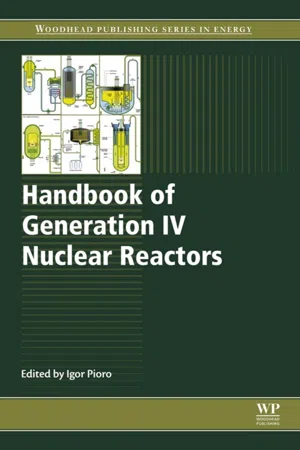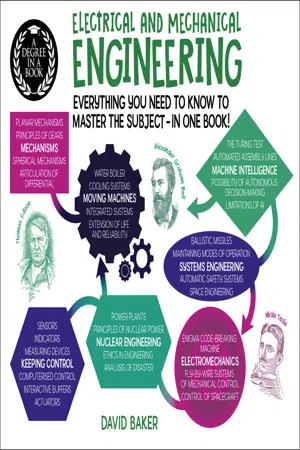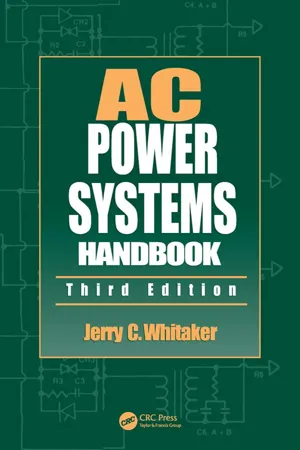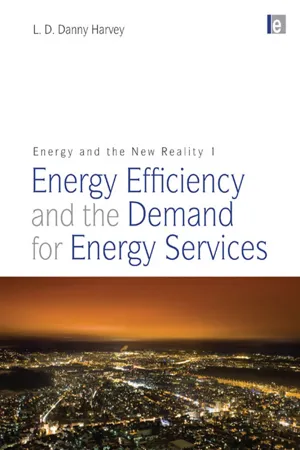Physics
Electricity Generation
Electricity generation is the process of producing electric energy from various sources such as coal, natural gas, nuclear, hydro, wind, and solar power. This is typically achieved through the conversion of mechanical energy into electrical energy using generators. The generated electricity is then transmitted and distributed to power homes, businesses, and industries.
Written by Perlego with AI-assistance
7 Key excerpts on "Electricity Generation"
Learn about this page
Index pages curate the most relevant extracts from our library of academic textbooks. They’ve been created using an in-house natural language model (NLM), each adding context and meaning to key research topics.
- eBook - ePub
- Paul Breeze(Author)
- 2014(Publication Date)
- Newnes(Publisher)
Chapter 14 on marine power generation. That aside, all practical and some still experimental means of producing electricity are included.History of Electricity Generation
The roots of the modern electricity-generating industry are found in the early and middle years of the 19th century and in the work of men such as André Ampère, Michael Faraday, Benjamin Franklin, and Alessandro Volta. It was during this period that scientists began to forge an understanding of the nature of electrical charge and magnetic fields. The chemical battery that converted chemical energy into electricity had also been discovered and permitted the properties of a flowing electrical charge (an electric current) to be explored. This also allowed the development of the telegraph, the first electrical means of communication. It was Faraday who was able to establish the relationship between electric currents and magnetism, a relationship that makes it possible to generate electricity with moving machinery rather than taking it exclusively from chemical batteries. His discoveries opened the way to the use of rotating engines as a source of electrical power.The widening understanding of electricity coincided with the development of the steam engine as well as the widespread use of gas for fuel and lighting. Lighting, in particular, caught the public’s imagination and one of the first major uses for electricity was as a source of light. In the United States, Thomas Edison developed the carbon filament that produced light from an electric current. Similar work was carried out in the United Kingdom by Sir Joseph Swan.Some of the first rotating machines used for Electricity Generation were based on water wheels and dynamos. However, water was not always available where power was needed and the trend among municipal power stations, the first important type of public power plant, was often to utilize steam engines and generators. These stations were initially built to provide electricity for lighting in cites. Early plants were generally small with a limited number of customers, but the area supplied by each power station gradually grew in size. At the same time there was little standardization and supply voltages varied from place to place and company to company. Meanwhile, there was an extended debate about the comparative merits of direct current and alternating current as the means of supplying electrical power. This was not resolved until well into the 20th century. - eBook - ePub
- Igor Pioro(Author)
- 2016(Publication Date)
- Woodhead Publishing(Publisher)
1Introduction
A survey of the status of Electricity Generation in the world∗
I.L. Pioro1 , R.B. Duffey2 , P.L. Kirillov3 , and R. Panchal11 University of Ontario Institute of Technology, Oshawa, Ontario, Canada2 DSM Associates Inc., Ammon, Idaho Falls, ID, United States3 State Scientific Centre of the Russian Federation - Institute of Physics and Power Engineering (IPPE) named after A.I. Leipunsky, Obninsk, RussiaAbstract
It is well known that electrical power generation is the key factor for advances in industry, agriculture, technology, and the level of living. In addition, a strong power industry with diverse energy sources is very important for country independence. In general, electrical energy can be generated from burning mined and refined energy sources such as coal, natural gas, oil, and nuclear as well as from harnessing energy sources such as hydro, biomass, wind, geothermal, solar, and wave power. Today, the main sources for electrical energy generation are thermal power, primarily using coal and secondarily natural gas; “large” hydraulic power from dams and rivers; and nuclear power from various reactor designs. The balance of the energy sources is from using oil, biomass, wind, geothermal, and solar power, and this has visible impact just in some countries. This chapter presents the current status of Electricity Generation in the world, various sources of industrial Electricity Generation, and the role of the nuclear power industry with a comparison of nuclear energy systems to other energy systems.Keywords
Electrical energy consumption; Electricity Generation; Human Development Index; Nuclear power; Thermal power1.1. Statistics on Electricity Generation in the world
It is well known that electric power generation usage is the key factor for advances in industry, agriculture, and the socioeconomic level of living (see Table 1.1 and Fig. 1.1 ; Pioro and Duffey, 2015 ; Pioro and Kirillov, 2013a ; Pioro, 2012 ). In addition, a strong power industry with diverse energy sources is very important for a country's independence. In general, electrical energy (see Fig. 1.2 - eBook - ePub
A Degree in a Book: Electrical And Mechanical Engineering
Everything You Need to Know to Master the Subject - in One Book!
- David Baker(Author)
- 2021(Publication Date)
- Arcturus(Publisher)
Having examined the fundamental principles of mechanical engineering in earlier chapters, and introduced the subject of electrical and electronic applications, we must now examine the use of mechanical principles to the need for generating electrical energy. We will limit ourselves to the mechanical processes of producing power distributed on national and local grids and networks, leaving mechanical processes involved in producing electricity from solar photovoltaic cells and by geothermal means to the next chapter. Finally, because engineers are at the forefront of discovering what is possible, we will look at the way we can plan for a more sustainable future using electrical energy sourced from technology that can reduce the human impact on the environment.A turbo-generator produced by Siemens in Germany.Dynamos and alternators
There are two ways of generating electromagnetic energy: the dynamo and the alternator .A simplification of the electrical power system from generation to customer in the USA.The dynamo
This device uses coils of wire and a magnetic field to convert rotary motion into a direct current, as laid down by Faraday’s law of induction , which predicts how a magnetic field will interact with an electric circuit to produce an electromotive force, or electromagnetic induction. The dynamo comprises a stator , or static structure, which contains a constant magnetic field, with a set of rotating windings known as the armature , which are made to rotate within that field. As explained by Faraday, the movement of the wire creates an electromotive force, pushing on the electrons in the metal and causing an electric current to run in the wire. Small machines can use magnets to provide the magnetic field but for larger machines requiring greater power, electromagnets are provided, sometimes known as field coils .From this alternating current, DC is enabled using a commutator , which is really a rotary switch accommodating a set of contacts on a shaft with graphite-block stationary contacts known as brushes - eBook - ePub
- Jerry C. Whitaker(Author)
- 2018(Publication Date)
- CRC Press(Publisher)
2Power-Generation Systems
_____________________________________________2.1 Introduction
Any ac power system begins with a generating source. Electric generators are devices that convert energy from a mechanical form into an electrical form. This process, known as electromechanical energy conversion, involves magnetic fields that act as an intermediate medium. The input to the generating machine can be derived from a number of energy sources. For example, in the generation of large-scale electric power, coal can produce steam that drives the shaft of the machine. Typically, for such a thermal process, only about 1/3 of the raw energy (i.e., from coal) is converted into mechanical energy. The final step of the energy conversion is quite efficient, with efficiency close to 100%.2.2 Fundamental Concepts
A simplified diagram of a three-phase generator is shown in Figure 2.1 . Note that poles A’, B’, and C’ represent the start of each of the phase windings, whereas poles A, B, and C represent the ends of each of the windings. As with transformers, the windings of the generator can be connected in either of two ways:• Wye configuration. A circuit arrangement in which the schematic diagram of the windings forms a Y.• Delta configuration. A circuit arrangement in which the schematic diagram of the windings forms a delta.Figure 2.2 illustrates the connection arrangements.The generator shown in Figure 2.1 is a rotating-field type of device. A magnetic field is developed by an external dc voltage. Through electromagnetic induction, a current is induced into each of the stationary (stator) coils of the generator. Because each of the phase windings is separated by 120°, the output voltage of the generator also is offset for each phase by 120° (Figure 2.3 - eBook - ePub
Sustainable Energy Transitions
Socio-Ecological Dimensions of Decarbonization
- Dustin Mulvaney(Author)
- 2020(Publication Date)
- Palgrave Macmillan(Publisher)
heat to operating complex computers. But how is electricity made?To understand this requires we revisit Ampere’s law and the laboratory work of Michael Faraday. Electricity is created from any process that forces electric charges apart. In a battery with electrodes at the poles that are by convention labeled positive—the anode—and the other negative—the cathode—the chemical composition of the battery is what forces charges apart. As the battery is depleted, the charge separation processes across this electric field lose their effectiveness, and the battery loses power. If the battery is a rechargeable one, external electricity can be added to restore the charge. Generators , batteries, fuel cells , and photovoltaic modules all utilize electric fields to make electricity.Distance between two charges affects electricity in an analogous way to how gravity affects two separate body masses, such as the Earth and the Moon. The force of attraction in gravity between two bodies is represented by Sir Isaac Newton as the universal law of gravitationHere, G is the force of gravity , while m and M are the mass of each of two respective objects. In the denominator, r is the distance between the two objects. As the masses are pulled apart, they exert less force on each other.Whereas the force (F ) of charge separation is represented asHere, k represents the electric constant, and the Q and q are the charges of the two objects. Once again, r is the distance between the objects. The strength of electric fields is characterized by the electric force per unit of charge. The electric force between objects is analogous to how the force of gravity relates across distance and mass. In each, force - eBook - ePub
Energy and the New Reality 1
Energy Efficiency and the Demand for Energy Services
- L. D. Danny Harvey(Author)
- 2010(Publication Date)
- Routledge(Publisher)
When a fossil fuel is burned, the chemical energy of the bonds in the fuel is converted to thermal energy. Some of this thermal energy is converted to electricity in the powerplant, and the rest is lost as heat that is dissipated to the environment (the surroundings). The reported energy content of a fossil fuel is the thermal energy that is produced when the fuel is burned. The efficiency of the powerplant is the fraction of this thermal energy that is converted to electricity. Thus:Conversely, the primary energy (fuel energy) required to produce a given amount of electricity is given by the electricity production divided by the powerplant efficiency. The higher the efficiency, the less primary energy required to produce a given amount of electricity.When there is a chain of processes with losses at each step, compute the efficiency for each step and multiply the efficiencies together in order to get the overall efficiency. For example, if the transmission of electricity entails a 7 per cent loss, the transmission efficiency is 0.93 (93 per cent). If the powerplant efficiency is 35 per cent, the efficiency of generation + transmission is 0.35 × 0.93 = 0.326.3.1 Some basics on electricity and Electricity Generation
Before discussing how electricity is generated using fossil fuels, it is useful to outline some of the basics of electricity.3.1.1 DC electricity
When a wire is connected to a battery, the electrons flow continuously in one direction. This is called direct current (DC) electricity. The force that makes electrons flow is called voltage potential or simply the voltage, and has units of volts. The electrical current is measured in units called amperes. The rate of energy carried (power, watts) by an electrical current is given by the product of voltage (V ) and current (I ):There is a resistance within the wire to the movement of electrons, given in units of ohms; this resistance causes some of the electric energy to be dissipated as heat, so there is a loss in electric energy. The resistance is normally assumed to be constant, although it increases slightly with temperature. The voltage drop over a resistance R - eBook - ePub
- DENNIS A SNOW(Author)
- 2001(Publication Date)
- Butterworth-Heinemann(Publisher)
22Electricity Generation
I G Crow, BEng, PhD, CEng, FIMechE, FIMarE, MemASME, BM & T Consulting LtdK Shippen, BSc, MBA, CEng, MIMechE, Chieftain Power ServicesContentsIntroductionGeneration of electrical powerDiesels Gas turbines Thermal power plant Gas turbines in combined cycleCombined heat and power (CHP)Steam turbines for CHP Diesels and gas turbines in combined heat and powerFactors influencing choiceThe available fuels The electrical load profile The heat load Power station auxiliary systems and services Site conditions Plant availability and maintenance Environmental aspects Generated voltagesThe selectionFor electrical power For combined heat and power Economic considerationsPlant and installationDiesel power plants Gas turbine power plants Steam turbogenerators Generators22.1 Introduction
Electricity is one of the key energy sources for industry and commerce. It is normally provided by the electricity supply companies, being generated from large fossil-fuelled, gas or nuclear central power stations and distributed throughout the country via high-voltage transmission systems. It can be fair to say that the electricity supply companies play a very important part in meeting the demands of the consumer efficiently, reliably and at an economic cost. However, there will always be a role for the private generation of electrical power, either to meet the needs for security of supply or to provide the electricity more economically. For the latter this is particularly the case for the concept of combined heat and power (CHP), where the local use of a heat demand can make private generation of electricity more competitive when compared with purchase from the local grid.This chapter aims to convey the basic technical principles involved in Electricity Generation for industrial and commercial applications, with supporting technical data giving examples of the performance and efficiency of various schemes. A general guide is provided on the factors which have a major bearing on choice of an electricity-generating scheme with further details of the plant, its layout and descriptions of actual installations.






